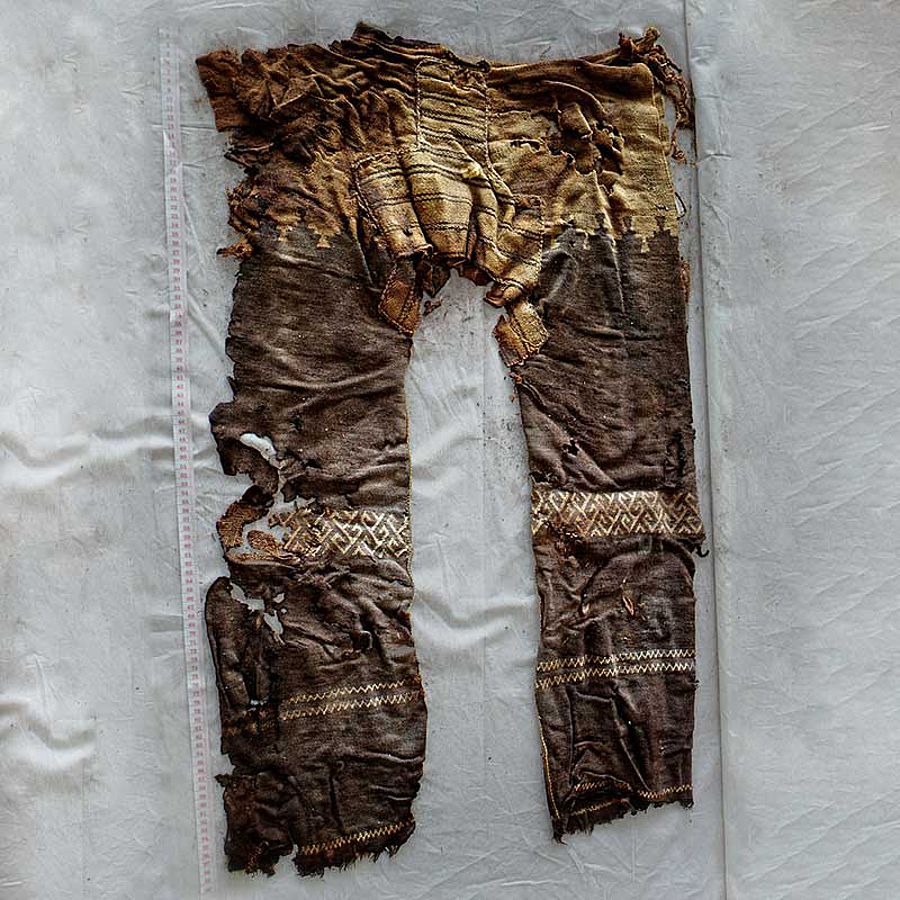Anthropology
Related: About this forumWhat a prehistoric pair of pretty pants can tell us about the spread of early languages
April 3, 2021 @ 12:04 am · Filed by Victor Mair
The following is a photograph of the world's oldest known pair of trousers:

Scientific study:
Ulrike Beck, Mayke Wagner, Xiao Li, Desmond Durkin-Meisterernst, Pavel E.Tarasov, "The invention of trousers and its likely affiliation with horseback riding and mobility: A case study of late 2nd millennium BC finds from Turfan in eastern Central Asia," Quaternary International, Volume 348 (20 October 2014), pages 224-235.
https://doi.org/10.1016/j.quaint.2014.04.056
Abstract
Here, we present the first report on the design and manufacturing process of trousers excavated at Yanghai cemetery (42°48′–42°49′N, 89°39′–89°40′E) near the Turfan oasis, western China. In tombs M21 and M157 fragments of woollen trousers were discovered which have been radiocarbon dated to the time interval between the 13th and the 10th century BC. Their age corresponds to the spread of mobile pastoralism in eastern Central Asia and predates the widely known Scythian finds. Using methods of fashion design, the cut of both trousers was studied in detail. The trousers were made of three independently woven pieces of fabric, one nearly rectangular for each side spanning the whole length from waistband to hemline at the ankle and one stepped cross-shaped crotch-piece which bridged the gap between the two side-pieces. The tailoring process did not involve cutting the cloth: instead the parts were shaped on the loom, and they were shaped in the correct size to fit a specific person. The yarns of the three fabrics and threads for final sewing match in color and quality, which implies that the weaver and the tailor was the same person or that both cooperated in a highly coordinated way. The design of the trousers from Yanghai with straight-fitting legs and a wide crotch-piece seems to be a predecessor of modern riding trousers. Together with horse gear and weapons as grave goods in both tombs our results specify former assumptions that the invention of bifurcated lower body garments is related to the new epoch of horseback riding, mounted warfare and greater mobility. Trousers are essential part of the tool kit with which humans improve their physical qualities.
Here are my initial reactions to this major publication, which I had intended to circulate years ago, but got caught up in too many other things:
These trousers are astonishing in many respects. First of all, they are exquisitely designed, woven, cut, sewn, and decorated. Second is their early date of late 2nd millennium BC, which makes them among the earliest known trousers on earth; if not, they are the very earliest archeologically attested, woven trousers. The next oldest known trousers are the burgundy colored pair worn by Cherchen Man / Chärchän Man / Ur-David (ca. 1000-800 BC), who was discovered in the cemetery of the village of Zaghunluq near the town of Qiemo (Chärchän), southeast Tarim Basin, about one thousand km SSW from the Yanghai burial ground at the edge of the Turfan Basin. Third is the sheer fact that these are trousers. Trousers / pants are hard to make, because you have to cut the fabric in irregular shapes, and then you have to sew them up into a crotch, which is a complicated business. But if you don't sew them right, that completely defeats the purpose of having a crotch after all, which is to make it easier to ride a horse.
Now, riding a horse is a revolutionary development in the history of humanity. We've talked about it a number of times on Language Log, so I don't need to explain in detail here and now how the horse expanded the power and reach of human beings. Why go to the trouble of cutting and sewing a crotch when it's so much easier to wrap a bolt of fabric round your waist — unless you want to straddle the back of a horse, and why go to the trouble of cutting and sewing a crotch if you make it in such a way that chafes the rider's sensitive nether parts unless you're serious about your horse riding.
More:
https://languagelog.ldc.upenn.edu/nll/?p=50713

NNadir
(34,969 posts)soothsayer
(38,601 posts)Very interesting
Vogon_Glory
(9,637 posts)in five, four, three, two...
Seriously, thanks for finding this and posting it.
modrepub
(3,664 posts)Are a Chinese invention?!? Sorry to turn this political. Interesting correlation.
PatSeg
(49,767 posts)I am trying to imagine any kind of fabric lasting that long. Incredible.
2naSalit
(94,458 posts)What I find fascinating is that the pieces of fabric were woven to shape and not cut. And they were woven to fit specific individuals, so the abstract says.
The patterns in the fabric, Are very similar to those found on the American continents as well.
It does make it clear how cultural practices and languages spread more rapidly once humans started riding horses and the like.
There is a very interesting discussion in the comments at the link.
central scrutinizer
(12,441 posts)The decorative design at the knees is a nice touch.